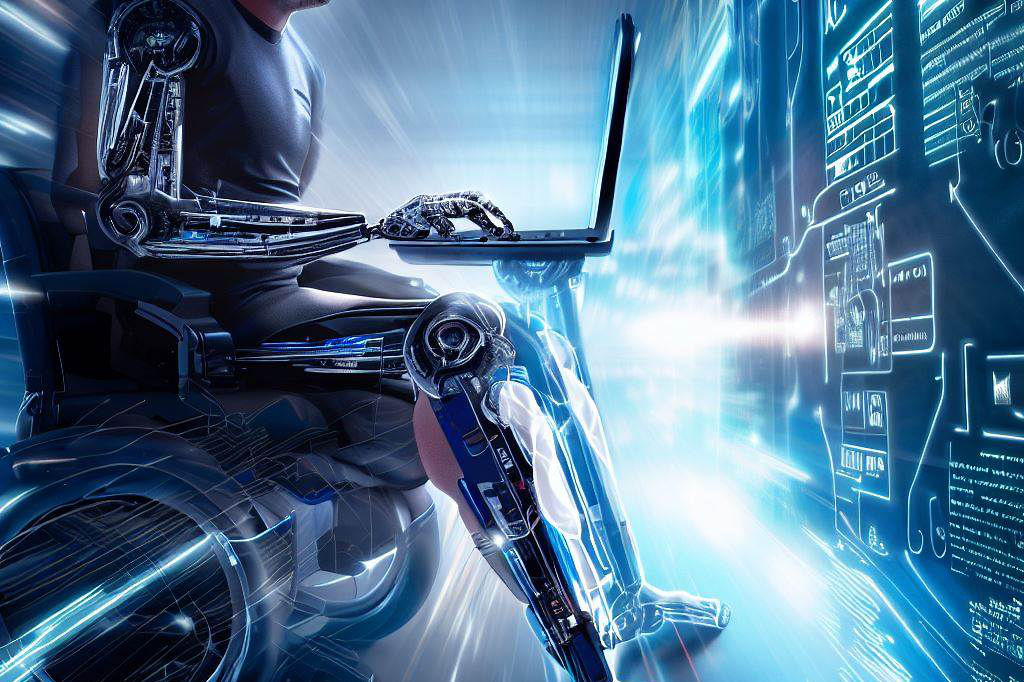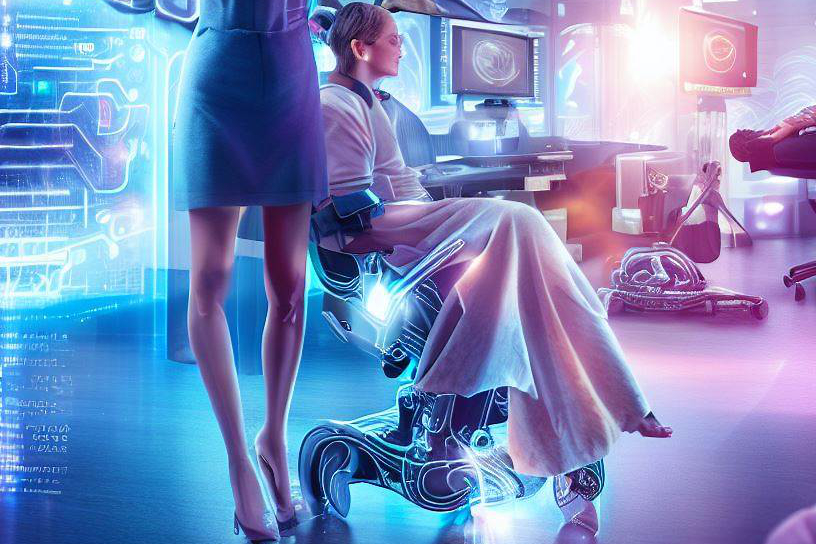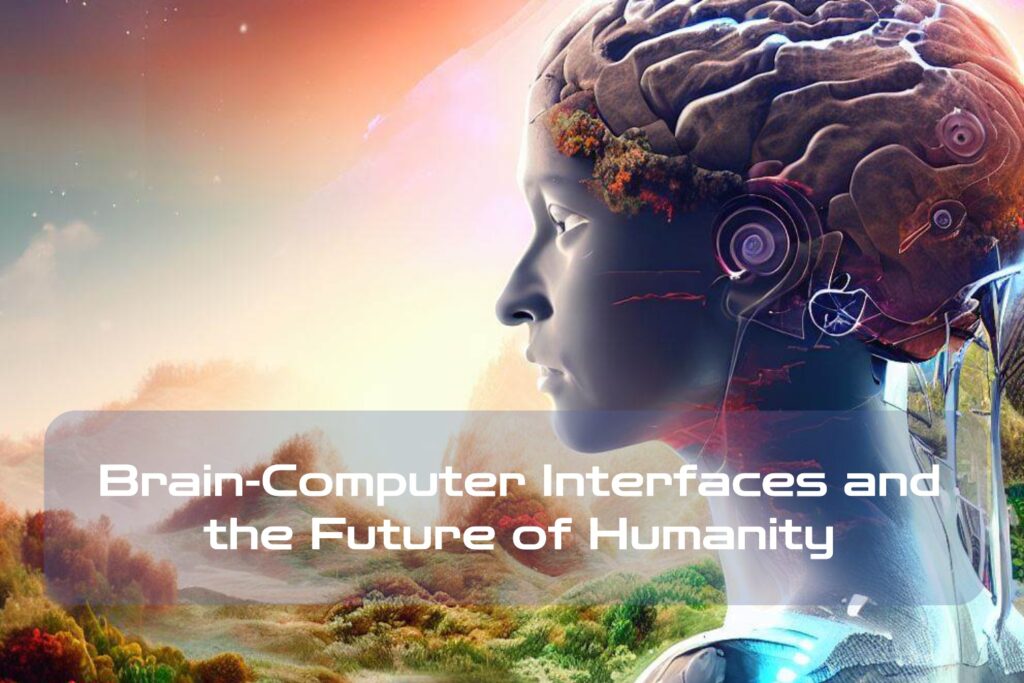The Dawn of the Neuralink Era: Brain-Computer Interfaces and the Future of Humanity
Exploring the Marvels of Brain-Computer Interfaces
In recent years, advances in technology have led to many exciting developments in science and medicine. One area that has been gaining a lot of attention is brain-computer interfaces (BCIs), which are devices that allow people to interact with computers using their thoughts.
BCIs have the potential to improve human communication, enhance memory, and even give people telepathic abilities in the future. At its most basic level, a BCI is a system that connects a human brain with an external device, such as a computer or robot.
The technology works by interpreting neural activity from different parts of the brain and translating it into commands that can be used to control devices or receive sensory feedback. Some BCIs require invasive procedures, such as implanting electrodes directly into the brain, while others are non-invasive and use external sensors placed on the scalp.

Introducing Neuralink – The Company That’s Pushing Boundaries
One company that has been making waves in this field is Neuralink, which was founded by Elon Musk in 2016. The company’s mission is to develop high-bandwidth BCIs that can be implanted directly into the human brain.
Neuralink aims to create an interface between computers and humans so seamless that it will feel like an extension of our own brains. In order to achieve this goal, they are working on developing ultra-thin “threads” (electrodes) less than one-tenth the width of a human hair that can be implanted into specific areas of the brain without causing damage.
The development of these advanced BCIs could revolutionize how we interact with technology, ultimately leading to more immersive virtual reality experiences, better medical treatments for neurological disorders such as Alzheimer’s disease or Parkinson’s disease, and even the potential for humans to communicate with each other without ever speaking a word. With the rapid pace at which technology is advancing, we may soon be on the verge of a new era in human evolution – one where our brains are directly connected to computers, unlocking vast new potentials for humanity.
Understanding Brain-Computer Interfaces
How BCIs Work
Brain-computer interfaces, also known as neural interfaces or brain-machine interfaces, are technological devices that allow humans to control computers or machines directly with their brains. This is achieved by recording and interpreting the electrical signals produced by neurons in the brain and translating them into actions outside of the body. BCIs work by using sensors placed on the scalp or directly on the brain to detect these electrical signals, which are then processed by software algorithms to interpret their meaning.
This information is then used to control a computer or machine in real-time. For example, a person could use their thoughts to move a cursor on a computer screen or even control a robotic arm.
Benefits of BCIs
The potential applications of BCIs are vast and could have significant implications for human society. One major benefit is increased mobility for people with disabilities, allowing them to use prosthetic limbs with greater ease and precision than ever before.
BCIs can also be used for communication purposes, such as enabling people who cannot speak due to paralysis to communicate through text-to-speech programs.
Another potential benefit of BCIs is cognitive enhancement. By directly connecting our brains to computers, we could potentially increase our memory capacity, improve our learning abilities, and even achieve telepathic communication with others who have similar implants.
Invasive vs Non-Invasive Methods

There are two main types of BCI methods: invasive and non-invasive methods.
Invasive methods involve surgical implantation of electrodes directly into the brain tissue itself, while non-invasive methods rely on sensors attached externally to the scalp.
Invasive methods tend to provide more precise readings because they can detect deeper-brain activity without interference from other signals; however, they require surgery, which increases risk factors such as infection or scarring around the implant site. On the other hand, non-invasive methods are less invasive and safer, but they provide less precise readings and require a lot of time commitment in order to get accurate results.
The Potential Benefits and Risks of BCIs
Breaking Boundaries: The Benefits of BCIs
The potential benefits of BCIs are immense, and they’re not limited to individuals with disabilities. For example, non-invasive BCIs can help enhance memory, improve communication skills, and even enable telepathic communication between people.
By connecting the human mind directly to machines or other humans, we may be able to achieve a level of interaction that was unimaginable just a few years ago. BCIs are also being explored as a tool for treating various neurological disorders, such as Parkinson’s disease and epilepsy.
With the help of invasive BCIs, it is now possible to stimulate brain areas that cause these diseases. This could ultimately lead to groundbreaking progress in treating conditions that were previously thought to be incurable.
The Ethics Question: The Risks of BCIs
Despite their many benefits, there are some ethical concerns surrounding the use of BCIs that cannot be ignored.
One concern is privacy – with invasive methods, particularly, there is an increased possibility for personal data leaks and hacking.
Another major concern is autonomy – if our thoughts can be monitored or manipulated by technology before they even become actions or expressions, then questions arise about free will.
There could also be consequences in terms of social inequality: those who are unable to access or afford BCI technology might find themselves at a disadvantage compared with those who can. While the potential for benefits from BCI technology is vast, we must ensure proper regulation and ethical considerations accompany its development in order to not only maximize its potential but also minimize the risks associated with its use so as not to create more harm than good.

The Rise of Neuralink
Elon Musk and the Origins of Neuralink
In 2016, Elon Musk founded Neuralink with the mission to “enable humans to communicate with computers and each other with a speed and bandwidth higher than what is currently possible.” For years, Musk has been vocal about his concerns over the potential dangers of artificial intelligence (AI), and he believes that BCIs could be a way to merge humans and AI in a way that is safe and beneficial. Musk has assembled a team of top neuroscientists, engineers, and other experts to work on developing Neuralink’s BCI technology. The company has already made significant progress in this field, including developing small implantable devices that can be surgically implanted into the brain.
Neuralink’s Mission
Neuralink’s ultimate goal is to create BCIs that are both safe for human use and highly effective at enhancing human capabilities. The company believes that its technology could revolutionize a variety of fields, from medicine to entertainment. One key area where Neuralink hopes its technology will make an impact is in treating neurological disorders.
By creating BCIs that can read brain activity more accurately than current methods, doctors may be able to better diagnose and treat conditions like Parkinson’s disease or epilepsy.
Another area where Neuralink hopes to make waves is in entertainment.
The company believes that its BCIs could one day allow people to experience virtual reality at unprecedented levels of immersion. Rather than simply seeing or hearing a virtual world, users could feel like they are actually inside it – all thanks to the power of BCI technology.
The Technology Behind Neuralink’s BCI Devices
The heart of Neuralink’s BCI technology lies in its implantable devices. These devices are small enough – about the size of a coin – to be implanted directly into the brain without causing damage or discomfort. Once in place, the devices can read and transmit signals from neurons in the brain, allowing for direct communication between the brain and a computer.
To make this possible, Neuralink has developed an advanced microfabrication process that allows for highly precise manufacturing of its implantable devices. The company has also created sophisticated algorithms that can interpret the signals generated by these devices, allowing for accurate decoding of neural activity.
All of this technology is still very much in its early stages, but Neuralink is making rapid progress. If Musk and his team are successful in their mission, we could be on the cusp of a new era in human-computer interaction.

Applications for Neuralink’s BCI Technology
Revolutionizing the Medical Industry
The medical industry could potentially greatly benefit from Neuralink’s BCI technology. For example, patients with paralysis could use BCIs to control robotic prosthetics with their minds, giving them greater independence and mobility.
BCIs could also be used to help patients suffering from neurological disorders such as Parkinson’s disease or epilepsy. With a BCI, doctors could monitor the patient’s brain activity in real-time and adjust their medication accordingly, leading to more precise treatment options.
BCIs could also play a crucial role in the future of mental health treatment. Patients with depression or anxiety disorders could have their brain activity monitored and analyzed, allowing doctors to create personalized treatment plans that are tailored to each individual patient.
The Entertainment Industry Goes Next Level
Imagine playing a video game that is controlled entirely by your thoughts. This is just one potential application for BCIs in the entertainment industry.
With Neuralink’s technology, gamers could experience more immersive gameplay than they ever thought possible. Even beyond gaming, BCIs can enable users to interact with movies in ways they never thought possible – pausing or skipping scenes simply by thinking about it.
Virtual reality (VR) is another area where BCIs can make a huge impact. Headsets equipped with BCIs will allow users to fully immerse themselves in a VR world through natural physical movements and gestures.
The Future of Education
Neuralink’s BCI technology has the potential to revolutionize education as we know it today. Classroom lectures can become more engaging and interactive by using BCIs that track students’ attention levels and provide feedback on areas where they need improvement. BCI technology has already been tested in educational settings with positive results – students were able to learn faster and retain information better when using BCIs as compared to traditional learning methods.
In the future, BCIs could be used to create personalized learning experiences based on individual students’ needs and preferences. The possibilities for Neuralink’s BCI technology are endless.
The applications discussed here are just a few examples of how this technology can bring about positive change across various industries. With continued research and development, Neuralink’s BCIs could transform the way we live, work, and interact with the world around us.
The Future Implications for Humanity
Changing the Human Experience

The potential implications of Neuralink’s technology are vast and far-reaching. The integration of human brains with advanced technological interfaces could bring about an entirely new era of human experience. Imagine being able to communicate via telepathy, expand your memory, or even control machinery with your thoughts.
The possibilities are endless. Perhaps most exciting is the idea that BCIs could help solve some of humanity’s biggest problems.
For example, BCIs could provide greater accessibility to education for those with disabilities. Additionally, BCIs could potentially revolutionize mental health by allowing people to better understand and control their emotions.
Societal Adaptation
Of course, any major technological advancement comes with its own set of societal challenges and ethical considerations. One concern is the potential for a “digital divide” between those who have access to advanced technology and those who don’t. Additionally, as more individuals integrate technological interfaces into their lives, questions around privacy and autonomy will become increasingly prevalent.
Despite these concerns, it’s clear that society will need to adapt in order to fully embrace the potential positive impacts of Neuralink’s technology. This may include updating laws and regulations and ensuring equitable access to these new forms of technology.
Final Thoughts
While there are certainly many questions surrounding the implications of Neuralink’s technology for humanity, there is no doubt that this development has the potential to be incredibly transformative in a positive way. From enhancing our physical abilities to expanding our cognitive capabilities, BCIs could open up an entirely new world of possibilities for humanity.
As we continue down this path towards a future where humans and technology become increasingly integrated, it’s important that we remain vigilant about addressing any negative consequences that may arise along the way. However, if we approach this development responsibly and thoughtfully, there is no limit to the positive impact that BCIs could bring to humanity.
Referenced in the Article Above:
- Neuralink – URL: Neuralink – Wikipedia
- Elon Musk – URL: Elon Musk – Wikipedia

C M, a seasoned editor, journalist, and consultant, is deeply fascinated by the convergence of technology, space, and the future of humanity.
With a particular interest in transhumanism, futurology, and the philosophical and ethical dimensions of these domains, C M serves as the lead contributor to TranscendSphere and SpaceSpotlight.
When not penning insightful articles on these rapidly evolving fields, C M indulges in their love for podcasts and books, proudly embracing their status as a ‘Happy Nerd Extraordinaire!’





